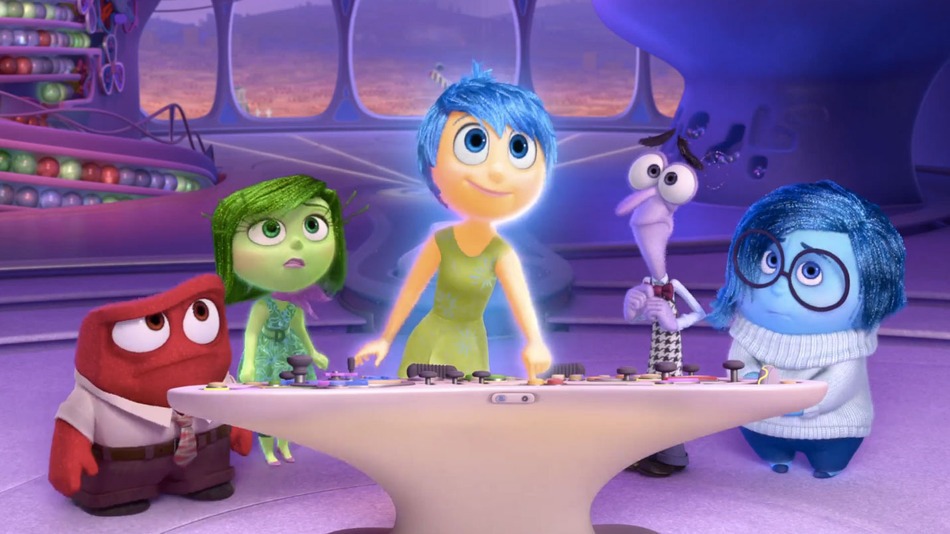
But sorrow isn’t always a burden. Sometimes it’s a salve.
Coming from a culture of children’s stories that focus on happy endings for the good guys, it’s a message that’s at once simple and unexpected. Inside Out isn’t concerned with saving the world or ridding it of evil. There are no villains and there is no hero. There’s simply a girl trying to learn the value of sadness and it’s ability to co-exist with joy; the undeniable collusion of the two.
Inside Out follows 11-year-old Riley (Kaitlyn Dias), a happy child whose life is uprooted when her parents decide to move from the Midwest to California. While Riley is our protagonist, we spend most of the movie with Riley’s feelings, exemplified by colorful characters living in Riley’s head and controlling her reactions to the world around her. The leader of that crew is Joy, voiced appropriately by Amy Poehler. Joy is the cartoon embodiment of Poehler’s character from Parks and Recreation, the eternal optimist known as Leslie Knope. She wrangles a crew of Riley’s other emotions, including Disgust (Mindy Kaling), Anger (Lewis Black), Fear (Bill Hader), and Sadness (Phyllis Smith). Kaling and Smith channel their characters from The Office, each with an edge towards their specific emotion. Black is, well… Lewis Black, and so on.
That’s honestly the whole external plot: Riley is shaken by the move and the loss of her friends, and suddenly Sadness begins to drive her reactions. But it’s what’s inside that counts here. When Joy attempts to take control of Riley’s reactions, Joy and Sadness butt heads and both end up accidentally being cast out of mission control entirely. The two feelings spend the movie trying to understand each other and make it back to mission control in one piece, but with Disgust, Anger and Fear too afraid to step up and take the wheel, Riley stops feeling anything. The word “depression” is never used, but it’s a clearly intelligent attempt to demonstrate what depression looks like to those who’ve never experienced it. Rather than an exaggerated or temporary dose of Sadness, depression is nothing.
Inside Out feels like a movie written by a parent who watched his or her child suddenly learn to deal with more complex emotions; a child learning how one thing can make you feel more than one way, rather than bouncing from one extreme to the next, and how confusing that can be. But it isn’t specifically a movie for children, either. In addition to a crew of fairly adult comedians and a mature message, the world-building is especially impressive, kids movie or not. We have the emotions “driving” Riley, core memories that shape her personality (they look like glowing bowling balls), and other colorful, physical representations of very abstract concepts.
As heavy as all of this sounds, it’s really the opposite – Inside Out manages to do all of this while being bright, fun, and a surprisingly hilarious movie. It’s fresh, clean air. The voice talent is a huge part of that, as well as the small moments we spend watching the emotional control centers of other characters (just imagine what the Emotional HQ of a hormone-driven teenage boy looks like and you’ll get the picture). But at the end of the day the credit is most likely down to Pete Docter, the film’s writer and director. Docter was the driving force behind Pixar’s 2009 feature, Up, which took home an Oscar for best animated feature.
It’ll be a huge shock if Inside Out doesn’t end up with similar accolades, and in my mind it’s a contender for best picture awards, animated or not. It’s not easy to pull off a movie that says something intelligent without being heavy-handed; that remains rooted in reality while living in imagination. But every now and then the planets align, the Movie Gods smile upon us, and we get a widely-popular, successful film that deserves every bit of it.
Here’s hoping (and knowing) that’ll be the case here.







this movie verry like,, i wait for season 2
great, i like this movie :)
This movie is very funny, I still remember how my aunt could not stop laughing
Wahhh thats very funny for this film. i like it! :D
Comments are closed.